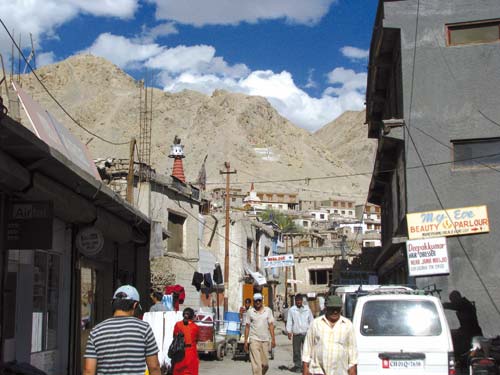With Chinese troops ‘occupying’ a part of eastern Ladakh for more than a fortnight now, it is the ‘unofficial’ trade between people at the borders that has become the first casualty. RS Gull filed this ground report on how China has been scoring over India in the arid desert over the last many years.

As a platoon strength Red Army stays in tents 19 km inside Eastern Ladakh for more than a fortnight, the resultant beef up in the security on either side of Sino-Indian Line of Actual Control (LoAC) has impacted an unlisted activity: the ‘trade’. Though not formally permitted, the ‘trade’ has never stopped on this ‘window’ to the silk route.
“The trickle of illegal trade continues for most of the year but the main trading season has already concluded,” Thupstan Wangchuk who represents Nyoma block in Leh’s Ladakh Autonomous Hill Development Council (LAHDC) said. “At the peak of winter in January and February, Chinese and Tibetan traders set up a huge market at Dumtsele where people go and barter.”
The border Dumtsele hamlet barely 20 km from Kuyul where the “confrontation” is currently taking place was part of Ladakh, according to Wangchuk. “It was wrested from us in 1962 war but nothing changed beyond claims. The local communities still have their connections intact,” he said. “Locals purchase a lot of things from this market: blankets, quilts, flasks, crockery, cigarettes, kitchenware, footwear and electronic items. It is a major source of economy for many people. Chinese sometimes take cooking oils and even medicines. Every third home in India has this Chinese flask.”
During the Beijing Olympics, special stalls were installed on the other side and there was lot of variety on sale, people privy of happenings in this Changthang belt activity, said. “Leh’s Moti market showcases what actually is being smuggled in”, said one police officer who served in the area. Owing to the presence of a number of security agencies desperate to know the happenings on the other side, the smuggling is directly or indirectly abetted by spies. “But it is difficult to judge whether it is smuggling abetted by spying or vice-versa”, the officer added.
In November 2009, four arrests were made in the region for attempted smuggling of 90 kgs of endangered caterpillar mushroom insects used in the manufacture of Chinese medicines. A month later, police recovered 50 tons of red sanders smuggled from Andhra Pradesh, a fragrant timber in huge demand for cabinet work and dyewood from Shey hamlet in Leh outskirts, before it could cross LoAC.
Locals say smuggling is the way of life. “Who will stop it and why?” asked one resident, Namgiyal. “The border is so huge that we don’t even have dogs to patrol them. Soldier appears only when there is a crisis.” K Khatana, an assistant commissioner in-charge of Custom Preventive Section (CPS) said it is ITBP that is deployed on the frontiers. “They seize the material and hand it over to us,” Khatana said. “Last year, we had five seizures and most of it takes place in winter when the Indus freezes.”
Various factors are responsible for allowing the trade. Firstly, security officials say, it is physically impossible to make LoAC impregnable. Secondly, both the countries apparently feel that the most peripheral belts on LoAC lack things because systems are unable to deliver. Thirdly, the rival armies have been in a way encouraging trade because it helps in collecting intelligence. Fourthly, the ‘trade’ has been happening for ages as there are less avenues available for people. Finally, New Delhi-Beijing have been less liberal as compared to Islamabad-Beijing in keeping the historic tracks open simply because it is geo-strategic versus geo-economic doctrines operational between the three nuclear neighbours.
Eastern Ladakh is home to two main links to the larger silk route. However, it is the Tibet route, known locally as the Damchok road that is part of the evolving discourse in Ladakh. “We have a common language and culture. The closure of Sinkiyang (Leh-Damchok-Tibet) road after 1962 has literally suffocated us”, P Namgyal, a former lawmaker from the region, said.
After Atal Behari Vajpayee visited Beijing in 2003, the two sides opted for another route at Nathu La in Sikkim. Damchok was supposed to be the fourth point but somehow it has not happened in these years. “See how people work at Chakan da Bagh (Poonch) and why we are being denied the same facility,” regrets Wangchuk.
Border disputes continue to be the major problem. Every year, PLA gets deep into the territory and stakes claims. It flies choppers that land on this side, distribute food items to sheep-herders of Changthang, paint rocks red with jingoistic slogans, stop laying of bridges that link nomadic Chang Pa’s with the vast pastures. More than once in recent years, PLA damaged the communication equipment of Indian Army. In certain belts, the PLA chases the shepherds and helps Chinese goat-herders pitch tents to control pastures. In last two years, PLA moved closer to LoAC and ‘almost controlled’ the entire Khak-jung area.
Everybody knows why nothing is happening even after Chinese are literally sitting in Leh. “Why should they (Army) act, they have to manage their two years of posting?” said Wangchuk. “There are even rumours that our outposts get foods from China,” his neighbour, a school teacher, added.
The rumour is not far-fetched. Leh genuinely depends on mutton “imports” from Tibet Autonomous Region, especially during winters.















